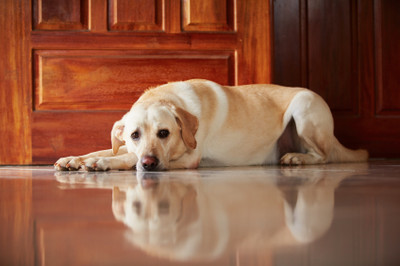Posted by Zena Conkey on Jul 25, 2020
How do you think your dog copes at home when you go out? Maybe you think he is quite happy because he doesn't chew anything or pee on the sofa? Unfortunately canine separation anxiety is more common than we think.

In fact many owners have no idea that the dog shows symptoms of stress when alone. Therefore they do not know how unhappy their absence can make their family dog. Dogs are group animals after all and they developed in family groups. The average canine will gravitate towards other dogs, and humans, quite naturally.
Canine separation anxiety can develop for a number of reasons. A puppy may have never learned to be happy when he is left alone, or he may have never been left alone at all. An older rescued dog may be feeling particularly insecure because of his past. Some dogs just want to be around their family so much that they just cannot deal with their own company.
Does your Dog Suffer with Separation Anxiety?
So how can you tell whether your dog is happy when you go out? In this age of technology it is easy enough to set up a pet webcam in order to keep an eye on your dog whilst you are not with him. A webcam or similar technology Pet Monitor is a great, and affordable, way to keep a careful eye on the movements of your canine friend when you are out. Otherwise most mobile phones provide some sort of recording service.
Set your camera up in order to get the very best view of your dog.
Separation Anxiety Symptoms
If your dog suffers from severe anxiety when you go out you will probably already know. He will chew something up or toilet in the home where normally he wouldn’t dream of it. The symptoms that you are looking for can also be very subtle, particularly if this type of anxious behaviour is just developing.
Here are some common symptoms of canine separation anxiety;
- Pacing around the home
- Watching from windows or staring at doors
- Chewing paws or skin
- Restlessness
- Licking his lips
- Panting
- Whining
- Barking
- Howling
- Destructive behaviour
- Scratching at doors
- Urination and defecation
A worried dog may show some or all of the symptoms described here. It can be quite upsetting to see this behaviour on camera for the first time but there are steps that you can take to make things easier on him. So what can you do if your dog is suffering?
Make Changes
The first thing to do, when helping a dog to cope with separation anxiety, is change the routine. Dogs do something that we call ‘chaining’ which means that they read sequences in our own behaviour in order to expect a certain conclusion.
So if you always turn on the TV, put on your work clothes, drink coffee and then turn off the TV before going to work, your dog can begin to feel separation anxiety right back when you turned on the TV.
By mixing things up a bit you can interrupt the thought pattern and your dog’s habit of becoming stressed. You can then make more pointed changes towards making the dog feel better whilst you are out.
If your dog is shut in a particular room whilst you are out then it will benefit him if you change this routine too, leave him somewhere else, because this will change the build-up of anxiety in his mind. If you normally leave the radio on, turn it off, leave the TV on instead.
One thing that works really well for separation anxiety is a comforting bed and toy. The idea is that a dog gets his ‘comforters’ whilst you are out and then they get taken away when you come home. A filled treat dispenser along with a cosy mattress will distract him from the anxious feelings.
A Separation Anxiety Program
There is little point in changing all of the above unless you are also going to retrain your dog’s mind. A program for separation anxiety will get a dog used to being happy alone, for short periods of time, then build up to longer spells. This will work best if coupled with the changes described above.
The idea is to teach a dog that, when his new bed and toy are on the scene, he can feel secure because you are coming back. You can help him to feel secure with his ‘comforters’ by leaving him for short periods, even going into another room for a while but returning before he becomes anxious. Always take his ‘comforters’ away when you return.
After this it is a case of leaving him with his new bed and toy, and building the time up carefully, to reform your dog’s thinking patterns and therefore his general anxiety when he is home alone.
